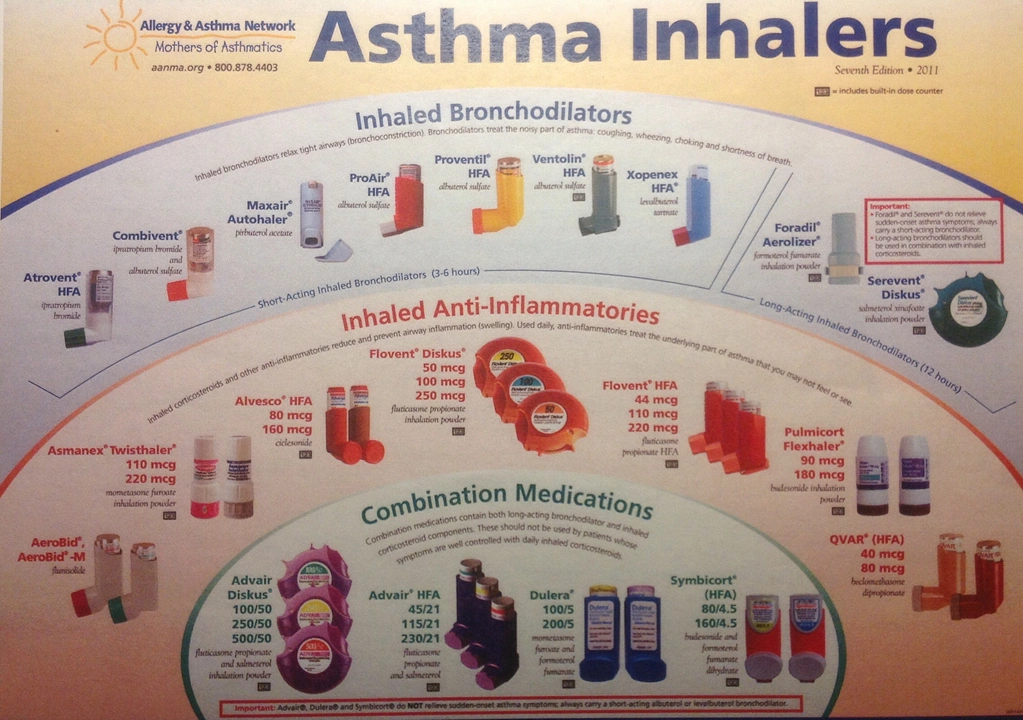Asthma Medications: What Works Best for You?
If you’ve ever struggled with wheezing or shortness of breath, you know how important the right medication is. Asthma meds come in several flavors, each built to open airways, reduce inflammation, or keep symptoms from flaring up. Below we break down the most common groups, when doctors usually prescribe them, and simple tips for getting the best results.
Quick‑Act vs. Long‑Term Options
Quick‑act (rescue) inhalers are your go‑to when an attack hits. They contain short‑acting bronchodilators like albuterol (Ventolin). A puff relaxes the muscles around the airway within minutes, giving you fast relief. Keep one handy at home, work, and in the car – you’ll thank yourself later.
Long‑term controllers work behind the scenes. Inhaled corticosteroids (ICS) such as fluticasone or budesonide shrink airway inflammation over days and weeks. You won’t feel an instant buzz, but regular use cuts down nighttime coughing and prevents flare‑ups.
Popular Delivery Devices
Metered‑dose inhalers (MDI) spray a fine mist that you inhale. They’re cheap and widely available, but timing matters – shake the can, exhale fully, then press while breathing in slowly.
Dry‑powder inhalers (DPI) like Advair Diskus rely on your own breath to pull medication into the lungs. No need to coordinate a button press, but you must inhale sharply. A recent comparison showed DPIs can be just as effective as MDIs for mild asthma when used correctly.
Soft mist inhalers create a slower, longer‑lasting cloud that may reach deeper parts of the lung. They’re a good alternative if you have trouble with hand‑breath coordination.
Beyond Inhalers: Pills and Biologics
If inhalers alone aren’t enough, doctors might add oral medications. Leukotriene modifiers like montelukast block chemicals that trigger inflammation. They’re handy for kids who struggle with inhaler technique.
For severe asthma that doesn’t respond to standard therapy, biologic injections (e.g., omalizumab) target specific immune pathways. These are usually given every few weeks at a clinic and can dramatically cut hospital visits.
Practical Tips for Safe Use
- Check the expiration date – old meds lose potency fast.
- Rinse your mouth after using a steroid inhaler to avoid thrush.
- Keep a written action plan: know when to step up from a rescue puff to a doctor’s visit.
- Store inhalers at room temperature, away from heat or direct sunlight.
- If you miss doses of a controller, take the missed one as soon as you remember unless it’s close to your next dose – then skip and continue regular schedule.
The right combo of rescue inhaler, daily controller, and lifestyle tweaks can make asthma feel like just another part of life instead of a constant worry. Talk with your healthcare provider about which devices fit your routine best, and don’t hesitate to ask for a demo if you’re unsure how to use them.
Remember, asthma isn’t one‑size‑fits‑all. Your medication plan might change as you age, travel, or develop new health issues. Stay informed, keep your inhalers clean, and track symptoms in a simple diary – the more data you have, the easier it is for your doctor to fine‑tune the treatment.

Albuterol vs. Other Asthma Medications: What You Need to Know
As someone with asthma, I've been researching the differences between Albuterol and other asthma medications. Albuterol is a quick-relief medication that helps open up the airways during an asthma attack, while other medications like inhaled corticosteroids are long-term treatments to prevent symptoms. It's important to know that Albuterol is not a long-term solution and should be used in combination with other medications for better asthma control. I've learned that using the right medication at the right time can make a significant difference in managing asthma symptoms. Remember to consult your healthcare provider to find the best treatment plan for your specific needs.
Detail



